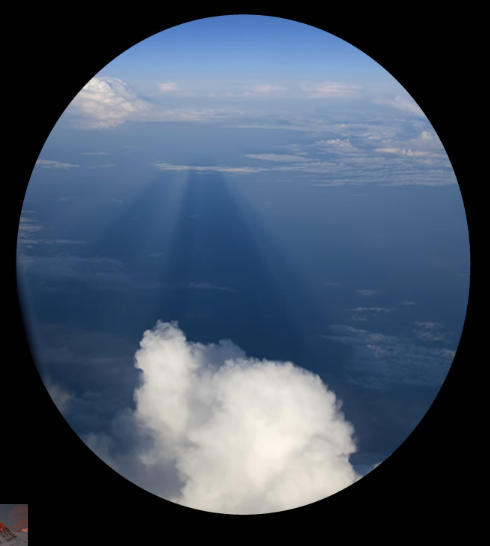OPOD - Sky of two halves
OPOD - Sky of Two Halves: A Captivating Atmospheric Phenomenon
Have you ever witnessed a mesmerizing sunset where the sky appears to be divided into two distinct halves? This captivating atmospheric phenomenon, known as a "Sky of Two Halves," occurs when a cloud bank on the horizon casts long shadows that stretch across half of the sunset sky. In this blog post, we will delve into the intricacies of this enchanting spectacle and explore its scientific underpinnings.
The Dance of Light and Shadows
The Sky of Two Halves is a visual spectacle that occurs when the setting sun casts its warm golden rays on the sky, while a cloud bank on the horizon acts as a barrier, creating long shadows that stretch across half of the sky. This unique interplay of light and shadows results in a striking contrast between the illuminated and shadowed portions of the sky, captivating the beholder with its ethereal beauty.
The Phenomenon's Vast Reach
Cloud shadows associated with the Sky of Two Halves can extend for more than a hundred miles, creating a breathtaking panorama that stretches across vast distances. These elongated shadows can be observed from various vantage points, providing an awe-inspiring visual experience for those fortunate enough to witness them.
The Science Behind the Sky of Two Halves
The Sky of Two Halves is a fascinating example of how light interacts with our atmosphere. When the sun is low on the horizon during sunrise or sunset, its rays must pass through a greater thickness of the Earth's atmosphere. This atmospheric scattering causes shorter blue and green wavelengths to disperse, leaving behind longer red and orange wavelengths that give the sky its warm hues.
When a cloud bank is present on the horizon, it acts as a barrier, blocking some of the sunlight from reaching certain areas of the sky. As a result, the cloud casts long shadows that stretch across half of the sky, creating a stark contrast between the illuminated and shadowed regions.
The Role of Atmospheric Optics
Atmospheric optics plays a crucial role in shaping the appearance of the Sky of Two Halves. The scattering of sunlight by particles in the atmosphere, such as dust, water droplets, and air molecules, contributes to the dispersion of light and the creation of vibrant colors in the sky. These atmospheric phenomena, combined with the presence of clouds, add an extra layer of complexity to the interplay of light and shadows, enhancing the visual impact of the Sky of Two Halves.
The Enchantment of Cloud Shadows
Cloud shadows are not limited to the Sky of Two Halves phenomenon; they can occur in various atmospheric conditions and landscapes. When clouds pass over sunlit areas, they cast shadows on the ground below, creating a dynamic interplay between light and darkness. These ephemeral shadows move across the landscape, constantly changing shape and size, adding an enchanting dimension to our visual experience of the world around us.
Capturing the Beauty
Photographers and enthusiasts are often captivated by the Sky of Two Halves phenomenon and seek to capture its beauty through their lenses. The striking contrast between the illuminated and shadowed portions of the sky, coupled with the vibrant colors produced by atmospheric optics, provides a captivating subject for artistic expression. These photographs not only serve as visual records but also inspire others to appreciate the wonders of our natural world.
A Momentary Marvel
The Sky of Two Halves is a fleeting phenomenon that occurs during specific atmospheric conditions. As the sun moves lower on the horizon, the angle at which its rays pass through the atmosphere changes, altering the interplay of light and shadows. This temporal nature adds to the allure of the Sky of Two Halves, making it a momentary marvel that reminds us of the ever-changing beauty of our planet.
A Reminder of Nature's Grandeur
The Sky of Two Halves serves as a reminder of the grandeur and complexity of the natural world. It highlights the intricate interplay of light, shadows, and atmospheric phenomena, showcasing the wonders that can be observed when we take a moment to appreciate the beauty that surrounds us. Whether witnessed firsthand or captured in photographs, this enchanting atmospheric spectacle leaves a lasting impression on all who experience its splendor.
Embracing the Magic
In a world filled with hustle and bustle, the Sky of Two Halves offers a moment of respite and awe. It invites us to pause, look up, and marvel at the magic unfolding above us. So, the next time you find yourself beneath a captivating sunset, take a moment to embrace the beauty of the Sky of Two Halves and let its enchantment wash over you.

Sky of two halves ~ Image by Robert Hayes. A cloud bank over the horizon has cast long shadows across half the sunset sky
©Robert Hayes, shown with permission.

Cloud shadows can stretch for more than a hundred miles. These were imaged by Jonathan Shock (john's travel adventures).
Note: this article has been automatically converted from the old site and may not appear as intended. You can find the original article here.
Reference Atmospheric Optics
If you use any of the definitions, information, or data presented on Atmospheric Optics, please copy the link or reference below to properly credit us as the reference source. Thank you!
-
<a href="https://atoptics.co.uk/blog/opod-sky-of-two-halves/">OPOD - Sky of two halves</a>
-
"OPOD - Sky of two halves". Atmospheric Optics. Accessed on November 26, 2024. https://atoptics.co.uk/blog/opod-sky-of-two-halves/.
-
"OPOD - Sky of two halves". Atmospheric Optics, https://atoptics.co.uk/blog/opod-sky-of-two-halves/. Accessed 26 November, 2024
-
OPOD - Sky of two halves. Atmospheric Optics. Retrieved from https://atoptics.co.uk/blog/opod-sky-of-two-halves/.